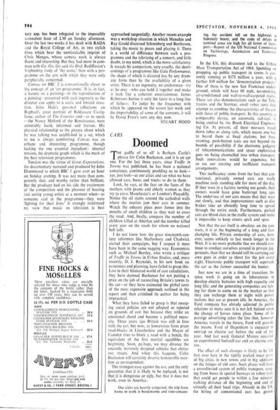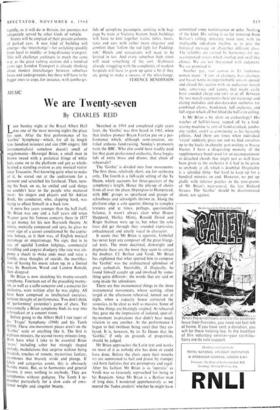Doomed
CARS TTIHE gadfly of us all' is Barbara Castle's I phrase for Colin Buchanan, and it is an apt one. For the last three years, since Traffic in Towns was published, he has been a national conscience, continuously prodding us to look— yes, just look—at our cities and see what we have allowed cars, buses and trucks to do to them.
Look, he says, at the fear on the faces of the mothers with prams and elderly women as they try to cross Manchester's or London's Piccadilly. Notice the oil stains around the cathedral walls where the tourists jam their cars in summer. Watch the exhaust pipes pour fumes into the mouths of small children as they wait to cross the road. And, finally, compare the number of children killed at Aberfan and the number killed every year on the roads for whom no national bell tolls.
I do not know how the great nineteenth-cen- tury reformers like Shaftesbury and Chadwick started their campaigns, but I suspect it must have been in the same nagging way. Economists such as Michael Beesley, who wrote a critique of Traffic in Towns in Urban Studies, and, more recently, D. J. Reynolds, in his new book on economics and planning, have failed to grasp this. Lost in their blinkered world of cost calculations, they have damned Buchanan for not putting a price on the job of reconciling Britain's towns to the car—or they have estimated the global costs of the most expensive approach outlined in the report and then criticised its author for being impractical.
What they have failed to grasp is that sweep- ing social policies are not adopted or rejected on grounds of cost but because they strike an emotional chord and become a political neces- sity. Three years ago Britain was still in love with the car, but now, as housewives form pram road-blocks in Lincolnshire and the Mayor of Camden tries to block a road with a bench, the equivalent of the first marital squabbles are beginning. Soon, peihaps, we may divorce the uncouth, narrowly designed vehicles that clutter our streets. And when this happens, Colin Buchanan will certainly deserve honourable men- tion as co-respondent.
The strongest case against the car, and the only guarantee that it is likely to be replaced, is not that it is dangerous or ugly, but that it does not work, even in America : Our cities are heavily congested, the trip from home to work is burdensome and time-consum- ing, the accident toll on the highways is hideously heavy, and the costs of delays in terminal areas are high for all forms of trans- port.—Report of the US National Commission on Technology, Automation and Economic Progress.
In the US, this discontent led to the Urban Mass Transportation Act of 1964. Spending on propping up public transport in towns is cur- rently running at $175 million a year, with a further $10 million for 'demonstration projects.' One of these is the new San Francisco under- ground, which will have 60 mph, no-smoking, air-conditioned and wall-to-wall-carpeted trains. There are also demonstrations such as the Tele- tranins and the Starrcar, small robot taxis that attempt to combine the characteristics of the car with those of public transport. In this country, a comparable device, an automatic rail-taxi, is being studied by the Brush Electrical Engineer- ing Co. At present, all these neo-cars travel down tubes or along rails, which means one has to board them at fixed stations; but free- roaming, push-button taxis are not beyond the bounds of possibility if the electronic gadgetry of telecommunications and space exploration goes on being channelled into urban transport. Such innovations would be expensive, but so are our existing and inefficient transport arrangements.
This inefficiency stems from the fact that con- ventional, privately owned cars are really machine tools standing idle for most of the day. If they were in a factory turning out goods, their owners would have gone bankrupt long ago. The under-use of our cars means that they wear out slowly, and that improvements such as disc brakes take an absurdly long time to spread through the entire stock. Furthermore, parked cars are blood clots in the traffic system and make it impossible to keep streets spick and span.
Not that the car itself is obsolete; on the con- trary, it is at the beginning of a long and fast- changing life. Private ownership of cars, how- ever, seems unlikely to last much longer in the West. It is no more probable that we should con- tinue to conduct ourselves around in private jug- gernauts, than that we should still be carrying our own guns in order to shoot for the pot every night. Electronic public transport will supersede the car as the farmer succeeded the hunter.
Just now we are in a time of transition. In- tense work is going on in laboratories to develop electric batteries with high capacity and long life; and the generating companies are itch- ing for them to come on to the market so that they can recharge them at night with power stations that are at present idle. In America, the Ford company has already adjusted its public relations to make sure it is not left behind when the change of horses takes place. Some of its prestige advertising takes the line that, however America travels in the future, Ford will provide the means. Ford of Dagenham is expected to unwrap an electric car before the end of the year. And last week General Motors unveiled an experimental fuel-cell car and an electric one, too.
The effect of such changes is likely to be felt first over here in the tightly packed inner parts of big cities, in new towns and in big additions on the fringes of old ones. Such places will have a co-ordinated system of public transport, rang- ing from buses in special busways to robot taxis that could get people to within a few minutes walking distance of the beginning and end of virtually all their local trips. Already in the US. the hiring of conventional cars has grown
rapidly, as it will do in Britain, for journeys not adequately served by other. kinds of vehicle.
Streets will be emptied of their present columns of parked cars. A new kind of building will emerge—the 'interchange'—for switching speedily from local to middle- or long-distance transport. This will challenge architects in much the same way as the great railway stations did a hundred years ago. London Transport is already thinking about modest interchanges between suburban buses and undergrounds, but there will have to be bigger ones to cope, for instance, with jumbo-jet- fuls of aeroplane passengers, arriving with bag- gage by train at Victoria Station. Such buildings will have to knit together trains, tubes, buses, taxis and cars with rather more elegance and comfort than 'follow the red light for Padding- ton.' Hotels and restaurants will need to be knitted in too. And every suburban high street w ill need something of the sort. Architects already struggling with the complexity of modern hospitals will have to grow up quite a bit if they are going to make a success of the interchange.
TE RENCE BEN DI XSON



































 Previous page
Previous page